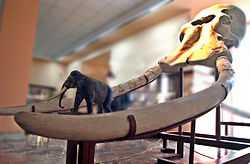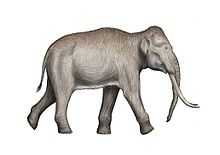Straight-tusked elephant
| Straight-tusked elephant | |
|---|---|
 | |
| A skull and model | |
| Conservation status | |
| Scientific classification | |
| Kingdom: | Animalia |
| Phylum: | Chordata |
| Class: | Mammalia |
| Order: | Proboscidea |
| Family: | Elephantidae |
| Genus: | Palaeoloxodon† |
| Species: | P. antiquus† |
| Binomial name | |
| Palaeoloxodon antiquus (Falconer & Cautley, 1847) | |
The straight-tusked elephant (Palaeoloxodon antiquus) is an extinct species of elephant closely related to the living Asian elephant. It inhabited Europe during the Middle and Late Pleistocene (781,000–50,000 years before present). Some experts regard the smaller Asian species, Palaeoloxodon namadicus, as a variant or subspecies.
Description

The creature was 3.9 m (13 ft) tall, weighing about 6,000–7,000 kg (13,000–15,000 lb), and had long, slightly upward-curving tusks.[1] P. antiquus's legs were slightly longer than those of modern elephants. This elephant is thought to have had an 80-cm-long tongue that could be projected a short distance from the mouth to grasp leaves and grasses.[citation needed] With this tongue and a flexible trunk, straight-tusked elephants could graze or browse on Pleistocene foliage about 8 m above ground.
Behaviour
Straight-tusked elephants lived in small herds of about five to 15 individuals.[citation needed] They preferred warm conditions and flourished in the interglacial periods during the current Ice Age, spreading from continental Europe to Great Britain during the warmer periods. It is assumed that they preferred wooded environments. During colder periods, the species migrated south. It became extinct in Britain by the beginning of the last glacial, about 115,000 years ago. Eventually it was replaced by the mammoth.
Excavations
_antiquus.jpg)
Finds of isolated tusks are relatively common in the United Kingdom. For example, a tusk of this elephant was found during the construction of the Swan Valley Community School in Swanscombe, Kent. However, finds of whole or partial skeletons of this elephant are very rare.
Skeleton finds in the United Kingdom are known from only a few sites. Two sites were found in the Lower Thames basin, one at Upnor, Kent and one at Aveley, Essex. Archaeological excavations in advance of High Speed 1 revealed the 400,000-year-old skeleton of a straight-tusked elephant in the Ebbsfleet Valley, near Swanscombe. It was lying at the edge of what would once have been a small lake. Flint tools lay scattered around, suggesting the elephant had been cut up by a tribe of the early humans around at the time, known as Homo heidelbergensis.[2]

On the European mainland, many remains of the straight-tusked elephant have been found. A handful of these sites even contain, besides a skeleton, archaeological material, as in the Ebbsfleet Valley (England). A skeleton at Lehringen (Germany) was found with the remains of a yew spear between it ribs and lithic artifacts around the head.
Straight-tusked elephant remains have been found with flint tools at a number of sites, such as Torralba and Aridos in Spain, Notarchirico in Italy, and Gröbern and Ehringsdorf in Germany.
Dwarfed descendants
Elephants presumably derived[citation needed] from the straight-tusked elephant are described from many Mediterranean islands, where they evolved into dwarfed elephants. The responsible factors for the dwarfing of island mammals are thought to be the reduction in food availability, predation and competition.

Notes
- ↑ R. D. E. McPhee Extinctions in Near Time: Causes, Contexts, and Consequences p.262
- ↑ BBC News. 2006. Early signs of elephant butchers. Downloaded at 2 July 2006 from http://news.bbc.co.uk/2/hi/science/nature/5128892.stm.
References
- BBC News. 2004. Stone Age elephant remains found. Downloaded at 2 July 2006 from http://news.bbc.co.uk/2/hi/uk_news/england/kent/3821527.stm.
- Masseti, M. 1994. On the Pleistocene occurrence of Elephas (Palaeoloxodon) antiquus in the Tuscan Archipelago, Northern Tyrrhenian Sea (Italy). Hystni, 5: 101-105. Online pdf
- Shoshani, J., N. Goren-Inbar, R. Rabinovich. 2001. A stylohyoideum of Palaeoloxodon antiquus from Gesher Benot Ya’aqov, Israel: morphology and functional inferences. The World of Elephants - International Congress, Rome 2001. pp 665–667. Online pdf
- Wenban-Smith, F.F. & Bridgland, D.R. 1997. Newly discovered Pleistocene deposits at Swanscombe: an interim report. Lithics 17/18: 3–8.
- Wenban-Smith, F.F. & Bridgland, D.R. 2001. Palaeolithic archaeology at the Swan Valley Community School, Swanscombe, Kent. Proceedings of the Prehistoric Society 67: 219–259.
- Wenban-Smith, F.F., P. Allen, M. R. Bates, S. A. Parfitt, R. C. Preece, J. R. Stewart, C. Turner, J. E. Whittaker. 2006. The Clactonian elephant butchery site at Southfleet Road, Ebbsfleet, UK. Journal of Quaternary Science. Volume 21, Issue 5, p 471-483.
External links
- Japanese Wiki article concerning the E. namadicus naumannni ja:ナウマンゾウ